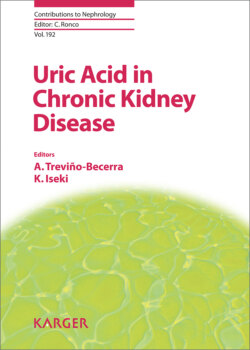Читать книгу Uric Acid in Chronic Kidney Disease - Группа авторов - Страница 34
На сайте Литреса книга снята с продажи.
A Model for Mild Hyperuricemia
ОглавлениеAs renal and cardiovascular involvement associated with hyperuricemia was detected after long-term exposure to increased concentrations of serum uric acid, it was hard to establish whether hyperuricemia was a marker of disease or a true causal factor in humans; therefore, a model of primary hyperuricemia was needed. The first challenge to solve was the fact that metabolism of uric acid differs between man and rodents; this is because in the former, UA is the last product of purine degradation pathway, while the latter expresses an uricase in the liver, which further degrades UA to 5-hydroxyisourate and then allantoin. A knockout mouse for uricase was developed, but the inactivation of this enzyme was lethal, as mice died at a young age due to obstructive acute renal failure caused by UA precipitation in renal tubules [5]. Therefore, this model did not reflect the progressive nature of long-term hyperuricemia (HU). A better model was developed by the blockade of uricase with oxonic acid [6]. Administration of this inhibitor on diet induced a rise in serum UA of 1.5–2 times that not precipitated in renal tubules. Hyperuricemic rats developed hypertension after 3 weeks, and this effect was prevented or improved by the concomitant administration of allopurinol or benziodarone to prevent UA synthesis or increase its urine excretion, respectively, or by oxonic acid withdrawal [6]. Also, hyperuricemia induced renal injury. Thus, markers of inflammation (ED-1+ cells and osteopontin) and fibrosis (collagen type III) were significantly increased in tubulointerstitium. Moreover, HU activated the renal renin-angiotensin system and inhibited NOS1 expression. Those findings were suggestive of renal vasoconstriction. Thus, enalapril and arginine administration prevented hypertension as well as the renal disease in HU rats [6]. Later on, it was shown that HU induced afferent arteriolopathy, characterized by the thickening of the media and an increased arteriolar area, which was independent of systemic hypertension but dependent on the activation of the intrarenal renin-angiotensin system [7]. Preglomerular vascular disease, ischemia, renal inflammation, and tubulointerstitial disease are conditions that result in salt-sensitive hypertension. In agreement, it was shown that the arteriolopathy and the tubulointerstitial changes secondary to HU, induced in the long-term salt-sensitivity was independent of serum uric acid concentrations [8].
Fig. 1. Proposed mechanisms by which uric acid (UA) causes Ht and CKD. Increased intracellular concentrations of UA affect endothelial, vascular smooth muscle (VSMC), mesangial, and tubular cells by inducing a prooxidant environment that activates proinflammatory, proliferative, senescence, and profibrotic pathways as well as endothelial dysfunction and the synthesis and secretion of vasoconstrictors. The activation of all these damaging pathways leads to systemic hypertension, which with time becomes salt-sensitive, and CKD.
Also, it was found that oxonic acid-induced HU resulted in higher blood pressure and greater renal damage in 5 out of 6 remnant kidney rats characterized by greater fibrosis, inflammation, and microvascular damage. Co-treatment with allopurinol blocked those alterations [9]. Therefore, long-term HU causes Chronic kidney disease (CKD) and also accelerates established CKD. Other models in which the pathogenic role of HU has been disclosed are cyclosporine-induced renal injury [10], diabetic nephropathy [11], and acute kidney injury [12, 13].
